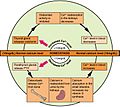Homeostasis facts for kids

Homeostasis is self-regulation, a basic property of all self-organising systems. In biology, it is the keeping of a stable internal environment.
The most important example of homeostasis is life. Animals keep their body in a stable condition. They do so by regulating their inner equilibrium. For example, they adjust their pH, temperature, amount of oxygen or carbon dioxide in the blood and so on. In living things, the study of how they keep in a stable condition is called physiology. Mostly, our physiology works unconsciously throughout life. We have many feedback systems which adjust our physiology so that we stay alive. These systems are self-organising and do not need to be learnt. They are inherited.
The concept was described by Claude Bernard, and the term was later coined by Walter Cannon in 1926, 1929, and 1932. Walter Cannon thought these were the features of homeostasis:
-
- Constancy in an open system, such as our bodies, is done by mechanisms which maintain this constancy. Cannon based this on insights into the ways by which steady states such as glucose concentrations, body temperature and acid-base balance were regulated.
- To keep a steady-state condition, any change automatically meets with factors that resist change. An increase in blood salt results in thirst as the body attempts to dilute the concentration of salt in the extracellular fluid.
- The regulating system doing homeostasis has a number of cooperating mechanisms which act simultaneously or successively. Blood sugar is regulated by insulin, glucagons, and other hormones that control its release from the liver or its uptake by the tissues.
Examples of homeostasis:
- The operation of a central heating system
- The regulation of water and minerals in the body
- The regulation of body temperature: mammals and birds have complicated systems which keep their body temperature within close limits.
In mammals, the main organs involved with homeostasis are:
- The hypothalamus and pituitary gland
- the lungs
- the skin
- the muscles
- the kidneys
- the liver and pancreas
The brain is also central to homeostasis. It controls behaviour, and the basic function of behaviour is to support life by taking action.
Related pages
Images for kids
-
Negative feedback at work in the regulation of blood sugar. Flat line is the set-point of glucose level and sine wave the fluctuations of glucose.
See also
 In Spanish: Homeostasis para niños
In Spanish: Homeostasis para niños






